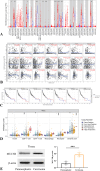MUC5B regulates alterations in the immune microenvironment in nasopharyngeal carcinoma via the Wnt/β-catenin signaling pathway
- PMID: 39786598
- PMCID: PMC11717746
- DOI: 10.1007/s12672-025-01772-4
MUC5B regulates alterations in the immune microenvironment in nasopharyngeal carcinoma via the Wnt/β-catenin signaling pathway
Abstract
Objective: To screen potential differentially expressed genes related to immune function in nasopharyngeal carcinoma through an online database, and to verify their mechanism of action, so as to provide a reference for the diagnosis and treatment of nasopharyngeal carcinoma in the future.
Methods: Differentially expressed genes were analyzed from the GSE227541 dataset, and functional enrichment analysis was conducted. With mucin 5B, oligomeric mucus/gel-forming as the focus, the correlation between its expression and immune indexes was analyzed by using the TIMER database. The expressions of mucin 5B, oligomeric mucus/gel-forming in clinical NPC tissues and adjacent tissue samples were detected Furthermore, mucin 5B, oligomeric mucus/gel-forming abnormal expression vectors were constructed and transfected into human NPC cell CNE-2Z to detect alterations in cell activity, ferroptosis and the immune microenvironment. In addition, the role of the Wnt/β-catenin signaling pathway in nasopharyngeal carcinoma was observed, and the influence of mucin 5B, oligomeric mucus/gel-forming on this pathway was discussed.
Results: A total of 42 differentially expressed genes were found in the GSE227541 dataset, among which mucin 5B, oligomeric mucus/gel-forming was obviously at the core of the entire network. In nasopharyngeal carcinoma tissues, the research team observed the upregulated expression of mucin 5B, oligomeric mucus/gel-forming (P < 0.05). In vitro, increased expression of elevated mucin 5B, oligomeric mucus/gel-forming activates nasopharyngeal carcinoma cell activity and immune escape and inhibits ferroptosis. In terms of pathways, upregulating mucin 5B, oligomeric mucus/gel-forming expression could activate the Wnt/β-catenin pathway.
Conclusions: Mucin 5B, oligomeric mucus/gel-forming regulates the immune escape of nasopharyngeal carcinoma cells and participates in tumor progression by mediating the Wnt/β-catenin signaling pathway.
Keywords: Bioinformatics; Immunization; Mucin 5B; Nasopharyngeal carcinoma; Oligomeric mucus/gel-forming; Wnt signaling pathway; β-catenin.
© 2025. The Author(s).
Conflict of interest statement
Declarations. Competing interests: The authors declare no competing interests.
Figures





Similar articles
-
Heterogeneity of airways mucus: variations in the amounts and glycoforms of the major oligomeric mucins MUC5AC and MUC5B.Biochem J. 2002 Feb 1;361(Pt 3):537-46. doi: 10.1042/0264-6021:3610537. Biochem J. 2002. PMID: 11802783 Free PMC article.
-
Overexpression of β-Catenin Decreases the Radiosensitivity of Human Nasopharyngeal Carcinoma CNE-2 Cells.Cell Physiol Biochem. 2018;50(5):1929-1944. doi: 10.1159/000494873. Epub 2018 Nov 5. Cell Physiol Biochem. 2018. PMID: 30396174
-
MicroRNA-506 inhibits tumor growth and metastasis in nasopharyngeal carcinoma through the inactivation of the Wnt/β-catenin signaling pathway by down-regulating LHX2.J Exp Clin Cancer Res. 2019 Feb 21;38(1):97. doi: 10.1186/s13046-019-1023-4. J Exp Clin Cancer Res. 2019. Retraction in: J Exp Clin Cancer Res. 2021 Sep 30;40(1):309. doi: 10.1186/s13046-021-02113-3. PMID: 30791932 Free PMC article. Retracted. Clinical Trial.
-
Chibby suppresses aerobic glycolysis and proliferation of nasopharyngeal carcinoma via the Wnt/β-catenin-Lin28/let7-PDK1 cascade.J Exp Clin Cancer Res. 2018 May 15;37(1):104. doi: 10.1186/s13046-018-0769-4. J Exp Clin Cancer Res. 2018. PMID: 29764469 Free PMC article.
-
HSP70 and mucin 5B: novel protein targets of N,N'-dinitrosopiperazine-induced nasopharyngeal tumorigenesis.Cancer Sci. 2009 Feb;100(2):216-24. doi: 10.1111/j.1349-7006.2008.01028.x. Cancer Sci. 2009. PMID: 19068094 Free PMC article.
Cited by
-
Integrated multi-omics profiling of immune microenvironment and drug resistance signatures for precision prognosis in prostate cancer.Cancer Drug Resist. 2025 Jun 25;8:31. doi: 10.20517/cdr.2025.47. eCollection 2025. Cancer Drug Resist. 2025. PMID: 40843359 Free PMC article.
References
-
- Dionisi F, Di Rito A, Errico A, Iaccarino G, Farneti A, D’Urso P, Nardangeli A, Bambace S, D’Onofrio I, D’Angelo E, De Felice F, Fanetti G, Belgioia L, Alterio D, Orlandi E, Merlotti A, Musio D, Sanguineti G. Nasopharyngeal cancer: the impact of guidelines and teaching on radiation target volume delineation. Radiol Med. 2023;128:362–71. - PubMed
-
- Yeh CF, Chin YC, Huang WH, Lan MY. Prior cancer history predicts the worse survival of patients with nasopharyngeal carcinoma. Eur Arch Otorhinolaryngol. 2022;279:5381–7. - PubMed
-
- Li T, Li F, Guo X, Hong C, Yu X, Wu B, Lian S, Song L, Tang J, Wen S, Gao K, Hao M, Cheng W, Su Y, Zhang S, Huang S, Fang M, Wang Y, Ng MH, Chen H, Luo W, Ge S, Zhang J, Xia N, Ji M. Anti-Epstein-Barr Virus BNLF2b for mass screening for nasopharyngeal cancer. N Engl J Med. 2023;389:808–19. - PubMed
-
- Lv J, Wei Y, Yin JH, Chen YP, Zhou GQ, Wei C, Liang XY, Zhang Y, Zhang CJ, He SW, He QM, Huang ZL, Guan JL, Shen JY, Li XM, Li JY, Li WF, Tang LL, Mao YP, Guo R, Sun R, Zheng YH, Zhou WW, Xiong KX, Wang SQ, Jin X, Liu N, Li GB, Kuang DM, Sun Y, Ma J. The tumor immune microenvironment of nasopharyngeal carcinoma after gemcitabine plus cisplatin treatment. Nat Med. 2023;29:1424–36. - PubMed
LinkOut - more resources
Full Text Sources
